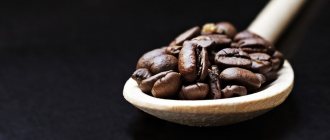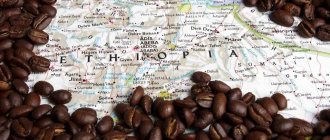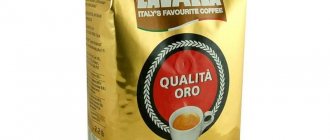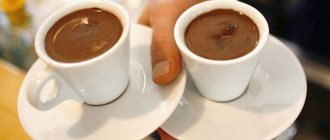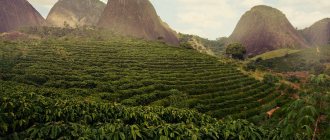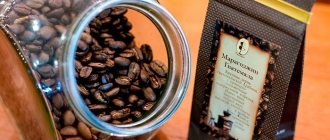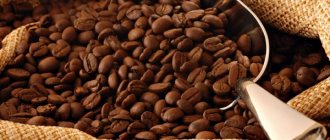about country
Uganda has ideal climatic conditions for growing coffee. Unfortunately, the same cannot be said about the political and social situation: the armed conflicts that have lasted for the last few decades have almost completely destroyed the economy and the coffee industry, especially in the 1990s, the West Nile region suffered. On the other hand, fertile volcanic soils and plenty of rain allow you to harvest two coffee crops a year, even without the cost of fertilizers and special technologies.
The country's coffee industry was once a state monopoly, but since the 1990s it has been entirely in the hands of private entrepreneurs. However, coffee exports are managed by the government institute Uganda Coffee Development Authority (UCDA), which sorts products and assigns categories and classes in accordance with accepted standards.
In cool mountain regions, the beans acquire a more complex bouquet. Almost all products are produced on small farms, and the coffee is grown in the natural shade of other trees.
Coffee cherries are most often processed using the wet method (the pulp is peeled from the fresh fruit), but some producers prefer traditional dry processing (the berries are dried in the sun, then the skins and pulp are removed).
In the period from 1996 to 2000, coffee brought more than 60% of all export income to the state treasury, every fifth person in the country makes money from the aromatic beans in one way or another.
Features of the local coffee industry
Technology in Uganda is still in its infancy – but that’s a good thing. Large coffee brands, shops and sommeliers prefer to cooperate with small farms that are ready to follow established criteria and adopt ready-made solutions. The trading house receives the goods, and farmers learn to cultivate coffee in accordance with the latest European developments, improve the quality of their product and can sell the beans at a better price.
Coffee is very rarely roasted in Uganda; green beans are mainly exported.
It is thanks to this practice that Ugandan Arabica, which no one had heard of 10 years ago, has earned worldwide recognition. Foreign “targeted” investments make it possible to improve infrastructure and financially reward farmers who have achieved exceptional results.
What to look for when buying, a review of tips
The popularity of bean coffee is enormous, and the range presented on the shelves is quite good. Prices are very different, so the question of choosing your favorite drink is very relevant. In order to know how to choose coffee beans, you need to be able to navigate its varieties.
The main types used in production are Arabica and Robusta. The first adds a refined taste and exquisite aroma. The Arabica drink is soft, invigorating with the taste of nuts, cream or chocolate.
Robusta is usually not used alone. If it is mixed with Arabica beans, the coffee becomes bitter and foamy. Robusta contains a lot of caffeine and is often featured in expensive varieties of grain drink. The variety has a lower yield compared to Arabica and takes longer to ripen.
Which coffee beans are best to buy, the choice can be made based on the roasting method used at the factory. You can choose by color, for example, undercooked greenish beans. The color changes depending on the degree of heat treatment. Experts distinguish between ten degrees of processing. The information is usually indicated on the label of any product: in a tin can, cardboard box or plastic packaging.
Coffee roasting
Light roast beans can be cinnamon, American or city. In the first method, the beans acquire the aroma of fresh bread. The second method produces beans that are light brown in color. The drink has an inexpressive taste. The third option is dark, the finished drink gives off a sour taste.
Universal roasting is considered ideal; it is also called medium roasting. This processing is divided into degrees. Full City Roast delivers amazing flavor. The finished drink has a certain viscousness. French or Viennese roasting produces a dark brown drink. The finished drink is tart, rich, and bitter.
Thanks to deep roasting, coffee acquires a dark hue, rich aroma and bitterness. These are usually Brazilian and Cuban Robusta, Guatemalan Arabica. The method is usually used when creating blends. Roasting is also called Mexican, Spanish or Cuban.
The espresso blend uses an Italian roast. In this method, the beans are deep-fried, then cooled immediately. The packaging for this coffee is a paper bag with foil inside. In this way, humidity is maintained and the oxidation process is inhibited.
Coffee machine or Turk?
The functionality of coffee machines and brewing coffee in a Turk varies.
Beans and coffee machine
The names Latte, Americano, Cappuccino, Macchiato, Moccaccino, Ristretto are familiar to many; a number of coffee machines offer built-in programs for their preparation. Recommendations for brewing espresso are available in almost every machine.
You can choose coffee for the coffee machine according to your own taste preferences. But for every preparation certain aspects are important. For example:
Grinding The largest one is needed for a French press. In the case of espresso, it is usually medium or fine. Filter coffee allows you to get a strong, bitter, rich drink. This method produces high, creamy foams.
If the grains are dark, as a rule, the grinding is done coarsely. What volumes are needed are usually determined automatically. More grains result in a stronger, richer drink. Automation estimates the quantity based on the set strength.
There is an option - a cappuccino maker, it is needed to create cappuccino and latte. Without this equipment, you can only prepare those varieties that do not require milk.
Grain and Turk
Making Turkish coffee has taken root in Russia. Cezve or ibrik are the original names of the device for brewing the drink. Grinding is also important here. Therefore, in addition to the Turk, this method also requires a coffee grinder.
In any case, filtration is not provided for in this brewing method, so the drink is drunk together with suspension. The aroma and taste of Turkish brew is different, as additional spices can be used. For example, cardamom goes well with beans. With this cooking method, it is suggested to add sugar immediately.
Coffee growing regions in Uganda
Ugandan coffee is cultivated in the following areas:
- West Nile (borders the Democratic Republic of the Congo and Sudan).
- Northern region (includes Lira, Gulu zones).
- Eastern region (Mbale, Bigusu zones, bordering Kenya).
- Central-southwestern region (Jinga, Mukono, Kampala, Masaka zones).
- Western region (Kasese, Mbarara zones, also borders the Democratic Republic of the Congo).
Western regions produce mainly Arabica.
Benefit for health
This type of coffee is actively used in the production of instant drinks and is especially good at helping to cheer you up in the morning.
Coffee in small doses, that is, about one cup a day, is beneficial for the body. After all, this drink contains not only caffeine, but also a lot of useful acids and vitamins, which in turn are a preventive measure against some terrible diseases, such as:
- cancer
- diabetes (both insulin-dependent and non-insulin-dependent)
- asthma
- cirrhosis of the liver
- various reproductive diseases
The distinctive beneficial properties of Robusta lie in its strength. Caffeine here is from 2%, coupled with beneficial biological acids, the drink has strong antioxidant properties. Also, a drink from Robusta tones up twice as much as from Arabica.
Characteristics of Ugandan Coffee
Local coffee has a velvety texture, a sweet chocolate flavor and a slightly tartaric acidity. The bouquet is not rich or complex; the drink is simple and light-bodied, not as distinctive as coffee from neighboring countries: Zimbabwe, Tanzania or Kenya.
The characteristics of the grain also depend on the altitude at which the plantations are located: coffee from high mountain regions is more acidic than its lowland counterparts. As for taste, there is no single profile; depending on the terroir and processing method, the finished drink can have a wide range of flavors, ranging from dried tomatoes to meadow flowers.
Uganda's specialty, Bugisu Arabica, stands out from the crowd with its pure flavor profile and distinctive aroma, and the country's coffee industry is focused on its development.
Uganda Bugisu (Bugisu) - local Arabica variety
Popular models and types of premium varieties
If inexpensive options are not suitable for some reason, you can find expensive brands on sale. For example, for recommendations, review our following list:
PAULIG Espresso Barista
The manufacturer from Switzerland offers an option consisting of 80% Arabica and 20% Robusta. Contains several types of grains. Coffee has a floral aroma, honey taste, nutty notes, and includes moderate bitterness. The product is suitable for coffee machines.
coffee beans PAULIG Espresso Barista
Advantages:
- excellent compatibility with milk.
Flaws:
- cannot be used for cooking in Turk.
The price of the product starts from 600 rubles for 2020.
Molinari
The variety includes both Robusta and Arabica. The combination gives a taste of chocolate with honey, a delicate aftertaste, a pleasant, tart aroma. The divine drink can only be prepared in a coffee machine.
coffee beans Molinari
Dignity:
- Optimal combination;
- bright taste.
Flaws:
- Price
Price – from 700 rubles per package for 2020.
Carte Noire
The Russian manufacturer offers a variety made from 100% Arabica. The raw materials are mainly Asian. When roasting beans, the new “Ice and Fire” standard is used. Technology reveals all the richness of taste. Domestic coffee is characterized by perfect harmony. The beans are suitable for a coffee machine.
coffee beans Carte Noire
Advantages:
- Flavored;
- duration of aftertaste.
Flaws:
- Expensive – 900 rubles per package for 2020.
Lucaffe 'Mr. Exclusive"
The drink contains only Arabica beans and is described as soft. The taste of the finished coffee is delicate with a subtle aroma and a sweet chocolate tint. This coffee bean can only be prepared in a coffee machine.
coffee bean Lucaffe 'Mr. Exclusive"
Advantages:
- Lack of sourness and bitterness;
- easy preparation;
- there are no low-quality grains.
Flaws:
- Sold in soft cardboard packaging;
- price from 1000 rubles per pack.
Malongo Italian Taste
The rating ends with prestigious French-made coffee with excellent taste and aroma. Arabica for this manufacturer is grown in Central America. Processing and roasting of beans is carried out using the classical method. The type of coffee produced is mild with floral notes and a sweet aftertaste.
coffee beans Malongo Italian Taste
Advantages:
- Good vacuum packaging;
- absence of low-quality grains;
- pleasant aftertaste;
- without bitterness.
Flaws:
- No.
The hefty price of 1,200 rubles per package is unlikely to stop real gourmets. These people usually don’t look at how much a pack of their favorite drink costs. Ordinary amateurs can make mistakes when choosing, so here are some tips.
Types and varieties of Ugandan coffee
Based on grain size, Ugandan coffee is divided into two categories:
- A (analogue of Colombian Exelso);
- AA (analogous to the Colombian Supremo).
Ugandan coffee varieties, as mentioned above, are represented by both Robusta and Arabica.
Robusta is an autochthonous variety; no one imported it (unlike Arabica, which appeared in the country only in the 1990s). In the forests of Uganda you can still find wild Robusta trees; local variations of this variety, Nganda and Erecta, are considered among the rarest in the world.
Methods for preparing Robusta coffee
This type of coffee can be brewed in several ways. Simple but interesting are the following.
Coffee "Oflameron"
Coffee "Oflameron" is an original recipe with champagne.
Grind the coffee and add a teaspoon to 60 grams of water. The water should be warm. Next, everything is heated over low heat, and when foam forms, a couple of spoons of champagne are added to the coffee (the gas is released first). When excessive foaming begins, remove the coffee from the heat.
Coffee Glace
Glace coffee has many fans all over the world.
To prepare this drink you will need coffee, ice cream, whipped cream, and syrup. To begin with, coffee is prepared in a Turk or in a coffee machine. An alternative could be a fench press. The cream is cooled in the refrigerator and whipped, syrup and sugar are added as desired. Ice cream is placed in special containers and filled with syrup. Later, coffee is added and whipped cream is placed on top.
Summary table of differences between Arabica and Robusta
For greater clarity, let’s put the main differences between Arabica Robusta in a table.
| Arabica | Robusta | |
| Historical homeland | Ethiopia | Congo River Basin |
| Share in sales structure (worldwide) | 70% | 30% |
| Growing properties | Grows at altitudes of 800-2200 meters above sea level, capricious, vulnerable, poor resistance to disease and weather | Grows in valleys and at altitudes up to 600 meters above sea level, resistant to diseases and climate fluctuations |
| Pollination | Cross | Self-pollination |
| Appearance | The grains are oblong, elongated, and acquire a uniform color when roasted. | The grains are round, small in size, and darken unevenly during roasting. |
| Basic chemical composition | 18% essential oils, 8% sugary substances, 1-1.5% caffeine, 6.5% chlorogenic acid | 8% essential oils, 4% sugar, 3% caffeine, 9% chlorogenic acid |
| Taste | Rich in shades, delicate, soft, multi-layered | Sharp, bitter, rough, simple |
| Aroma | Steady, strong | Weak |
| Fortress | Medium and low | High |
| Application | Alone and as part of mixtures | As part of mixtures |
| Price | Arabica is more expensive than robusta due to the greater risks and costs of cultivation | Robusta is at least 2 times cheaper than Arabica |
Now you will know exactly what to expect from each variety. Enjoy your coffee.
Usage
Robusta has a much higher content of tannins, which are responsible for bitterness, than Arabica.
Arabica and Robusta differ in purpose. The first type is used in its pure form; an aromatic, weak drink is prepared from it. And the second is suitable for espresso, as it has a powerful invigorating effect. It is also added to mixtures for making coffee, and is also used as a base for creating instant drinks. Robusta is drunk in its pure form only by true connoisseurs who like its bitterness and tart taste.
Arabica and Robusta - growing conditions
Let's start with the basic differences - history, geography and features of growing aromatic grains.
Arabica
Its homeland is the highlands of Ethiopia, although this species of coffee tree is often called Arabian. This is due to the long-standing story that the merchants of the Arabian Peninsula highly valued the aromatic grains and took out Arabica trees to plant on their land. The plants took root well and made the territory of present-day Yemen a real coffee Mecca of the ancient world.
Moka was the name of the drink in other countries, named after the port city from which the strange grains arrived. Although there is evidence that in Yemen itself there were also plantings of coffee trees, just near the very port of Mocha.
Arabica trees grow at altitudes of 800 meters above sea level. The best grains in terms of quality and taste are obtained at an altitude of 1500-2000 meters.
A special feature of Arabica cultivation is the vulnerability of the trees. They are susceptible to disease, do not tolerate temperature changes well, and for a good harvest they need not just a favorable, but a stable climate. Arabica has a very narrow comfort zone, and the slightest violation of it immediately affects the berry harvest. The problem with this vulnerability lies in the characteristics of pollination. Arabica requires cross-pollination, hence the rapidity of infection and mutation.
People tried to overcome the vulnerability of Arabica through active selection of the most resistant varieties. As a result, plants appeared with better endurance characteristics, but at the same time retaining the taste of the grain. These are Typica, Bourbon, Maragogip. They are called old Arabica, since the peak of their distribution occurred in the last century.
Today's breeding experiments are more aimed at increasing yields and reducing the risks of growing coffee, so many newly bred Arabica varieties, although they bring more yield, are inferior in taste to their predecessors.
Robusta
Originally from Africa, it is even called the Congo tree, after the name of historical plantings first discovered in the floodplain of the Congo River.
At the very beginning of the last century, the seedlings were delivered to the island of Java and very quickly took root in the new place. Robusta was then spread to South America and southeast Asia.
Modern regions for growing robusta practically repeat the distribution of arabica: South and Central America, Africa, southeast Asia. However, there are countries where the cultivation of robusta is strictly prohibited in order to avoid interbreeding of species. For example, in Colombia and Costa Rica.
The main difference between this coffee tree is its high stability. Robusta literally means “strong”. The species calmly withstands temperature changes and high humidity, grows well in low-lying areas and even in valleys, which Arabica is simply not capable of. Among the advantages of Robusta is its resistance to the scourge of Arabica - rust. It was this disease that once destroyed almost all Arabica plantings in Brazil in a couple of years. After which farmers replaced the capricious Arabica with a less capricious species.
Robusta's stability is largely due to self-pollination, hence its good resistance to external influences.
Robusta undergoes constant selection in order to improve the taste of the grains. The best varieties of Robusta are considered to be Nanu, Java Ineak (one of the first Javanese varieties), and Conillon Brasil.
The cost of growing a kilogram of Robusta beans is much lower than Arabica. This explains the growing popularity of hybrid varieties, because they allow you to make much more profit than the capricious and pampered trees of typical Arabica.
Farmers believe that the future lies in combining the qualities of Arabica and Robusta in new breeding varieties.
Producing countries
Arabica is produced in the following countries:
- Brazil;
- Guatemala;
- India;
- Indonesia;
- Mexico;
- etc.
Robusta grows in Indonesia, Brazil, India, and also in Central African countries. Its share of the world coffee market is 25 percent. The share of arabica coffee beans is respectively 75 percent.
Features of cultivation
The growing altitude of Arabica coffee is 600–2200 m above sea level. Plants grow on a mountain landscape. The optimal air temperature for them is +15…+24 °C. For successful cultivation, 1200–2000 mm of precipitation is required per year.
Robusta is a tree that prefers to grow on flat terrain, rising up to 800 m above sea level. It is more demanding of heat and moisture. The optimal temperature is +18…36 °C, the annual precipitation level is 2000–3000 mm.
Despite the apparent unpretentiousness of arabica coffee trees, they are more difficult to cultivate. They are more susceptible to parasites, bacterial, viral, and fungal diseases. This is due to the fact that this type of coffee contains the least amount of caffeine, which prevents plants from being damaged by pests and infections.
Coffee trees
The Arabica coffee tree grows high in the mountains. Therefore, it grows only up to 4.5 m, less often - up to 5 m. Due to low air temperature and lack of moisture, this tree cannot achieve greater growth.
Robusta grows in places where the soil is rich in nutrients and moisture. In favorable conditions, the plant can reach a height of up to 10–12 m. But more often, tree trunks grow up to 6–7 m.
Appearance of grains
Collected and cleaned, Arabica and Robusta beans have pronounced external differences.
Arabica and Robusta beans differ significantly in appearance. In the first species they reach up to 8 mm and have an oval shape. After roasting, the beans have an even brown color.
The shape of the Robusta grain is closer to a circle. They are smaller in size than Arabica beans. After roasting, the color of the beans does not become uniform; they can have several shades of brown.
Arabica and Robusta - differences
Both types of beans in total cover the entire coffee needs of the planet's citizens. If we talk about percentages, the share of Arabica in consumption is 70%, Robusta – 30%. There are many varieties of both species that have been developed by humans through breeding and selection. This is where all the variety of coffee comes from, but all varieties sold are either Arabica, Robusta, or a mixture of beans in different proportions.
The main differences between Arabica and Robusta are the growing conditions of the plants and the chemical composition that shapes the taste properties of the beans and the finished drink.
